#Cosmographie Universelle
Text
An aquatic feline from Librum Prodigiosum! The Orabou, a legendary fish described in French cosmographers André Thevet’s Cosmographie Universelle in 1575- a work made to describe every part of the known world. This unusual beastie was said to live in the ocean by Mount Marzouan, they were 9 feet long and apparently had foul-tasting flesh which caused kidney stones if ingested!
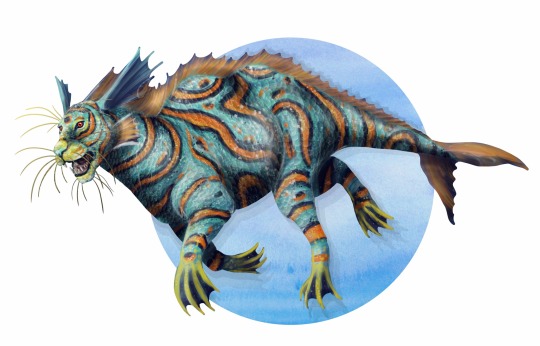
#digital art#digital illustration#fantasy#art#folklore#mythology#monster#librum prodigiosum#mythical creatures#creature#artists on tumblr#mythology art#mythologyart#sea monster#orabou#Cosmographie Universelle
90 notes
·
View notes
Text

This 16th-century artwork is of a 'haut', which are said to live in the trees. It has been identified with species of three-toed sloths such as Bradypus variegatus which are found in the forests of Central and South America. This artwork comes from 'Cosmographie universelle' (1575) by the French explorer and writer Andre Thevet (1516-1590). The book describes the history and geography of the lands in which Thevet had travelled. The two volumes contain over 1000 pages divided into 23 books. This woodcut is from chapter XIII of book XXI.
#library#law library#libraries#rare books#history#books & libraries#rarebook#london#mtlibrary#inns of court#sloth#south america#16th century#early printed books#explorer#nature#animals#wildlife#1500s#artwork
375 notes
·
View notes
Text

Windrose. Cosmographie universelle, selon les navigateurs tant anciens que modernes. 1555.
Gallica
450 notes
·
View notes
Text

A French Galleon from Guillaume Le Testu's Cosmographie Universelle 1555
40 notes
·
View notes
Text







Il y a une petite quinzaine, je suis allé avec Julien et Katie, au Louvre-Lens pour une expo temporaire : “Animaux Fantastiques”. Une très belle expo ! Ici des licornes :
monument pour Renée d'Orléans Longueville, licorne tenant ses armoiries - église des Célestins, Paris, 1515
aquamanile en laiton, licorne - Nuremberg, 1420
André Thévet - "Cosmographie Universelle'" le "camphruch", sorte de licorne amphibie censée vivre en Indonésie - Paris, 1575
dent de narval + bronze et soie - 1600
Maître S.K. - "Orphée jouant du violon devant les animaux"- 1583
Ehrard Reuwich, illustration pour le livre de Bernhard von Breydenbach - ''Pèlerinage en Terre Sainte'' - Mayence, 1502
voir 1
#expo#louvre-lens#animaux fantastiques#monstre#créature#licorne#renée d'orléans longueville#église des célestins#médiéval#renaissance#nuremberg#allemagne#aquamanile#andré thévet#cosmographie#camphruch#narval#défense de narval#maître S.K.#orphée#ehrard reuwich#bernhard von breyendach#mayence
7 notes
·
View notes
Text
Quand le français était universel
Détail d’un ouvrage multilingue rassemblant une cinquantaine de textes – histoire, géographie, cosmographie, littératures et religions (entre 1307 et 1350)
“Sourdez vous le cul tost et apareillez a diner !” Comment activer un aubergiste, réprimander un valet ou insulter un chauffard dans la France médiévale ? Les manuscrits exposés à la bibliothèque de l’université de Cambridge, en…

View On WordPress
2 notes
·
View notes
Text
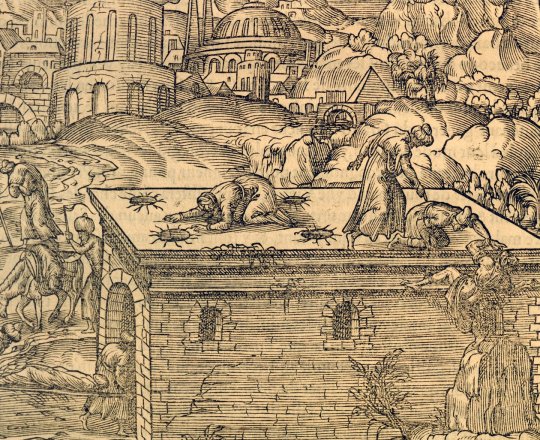
Christian cemetery of Acheldemach, engraving from Cosmographie universelle, by Andre Thevet (1504-1592), Paris
Artist: Andre Thevet
0 notes
Text
Medieval Marginalia
Whether we like to admit it or not, we have all doodled in the margin or on a photo in a book at one time in our lives. Doodling has been a component of writing since people starting writing their thoughts on cave walls. On this Tumblr page, I am going to share some of the more weird and wacky medieval marginalia that has been found and cataloged.
Let's start off with a cuddly animal everyone loves! Bunnies!!

public domain
These are no ordinary bunnies!!! These are killer bunnies.

public domain France 13th cent. Royal 10 BL

public domain La Somme le Roy, France ca. 1290-1300. British Library, Add. 28162, fol. 12v

public domain

public domain

public domain Breviary of Renaud de Bar, Verdun, Bibliothèque municipale, MS 107, fol. 96 v .

public domain Breviary of Verdun. Image: Verdun, Bibliothéque municipale, MS 107, fol. 141v.
It looks to me like they are exacting their revenge!
Did one smart rabbit get a whiff of what what was cooking in the house?
Silly human, rabbits can't read!
Let's take a look at a few more categories of marginalia!
The cost of a book in the 12th -14th century was astronomical. Only the literate elite could afford them. Just imagine you acquire a one-of-a-kind handmade book and you open up to see in the margin, a man who farts, or find a tree of male appendages at the bottom of a page.
Which brings us to our next category:
Rear ends and appendages
This upside-down world found in the sacred texts is very perplexing. I would love to be a medieval fly on the wall when the book purchaser gets his book delivered, sits down in his very uncomfortable 13th century chair, and beholds this glorious illuminated manuscript to find butt trumpets. Many, butt trumpets.

public domain from the Rutland Psalter, c. 1260. (British Library Royal MS 62925, f. 87v.)

public domain

public domain The Vows of the Peacock c. 1350

public domain

public domain

public domain

public domain

public domain
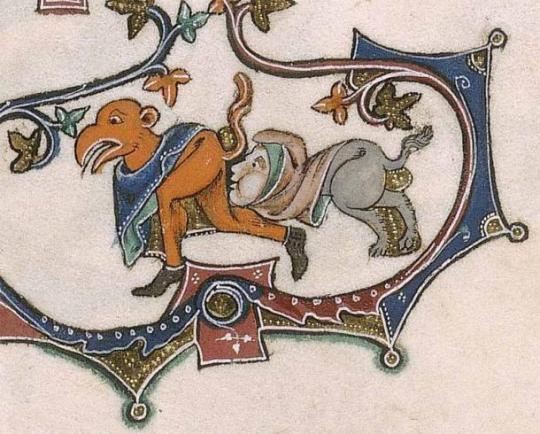
public domain Maccesfield Psalter
Appendage elements were also prevalent in early marginalia.
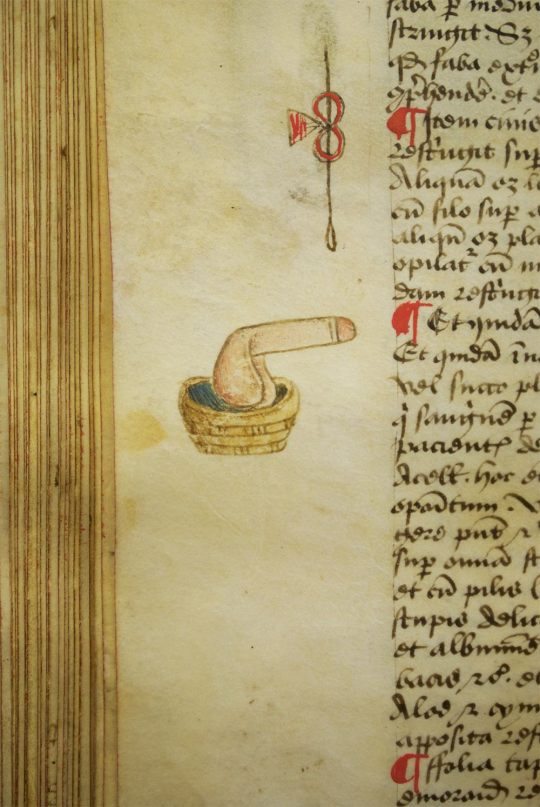
public domain Arderne’s treatise. GLASGOW UNIVERSITY LIBRARY MS HUNTER 251 (U.4.9)

public domain from the Roman de la Rose, c. 1325-1353. (Paris, Bibliothèque nationale de France, MS. Fr. 25526, f. 106v.)
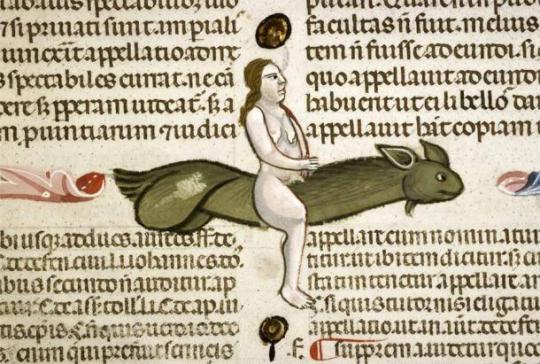
public domain Decretum Gratiani with the commentary of Bartolomeo da Brescia, Italy 1340-1345. Lyon, BM, Ms 5128, fol. 100r
Not all marginalia is grotesque, vulgar, and crude. There are many whimsical and charming examples, too!
Here are just a few random styles that do not fit into a specific category.

public domain from the Summer volume of the Breviary of Renaud and Marguerite de Bar, Metz ca. 1302-1305. (Verdun, Bibliothèque municipale, MS 107, f. 99v.)

public domain Cosmographie universelle, selon les navigateurs tant anciens que modernes / par Guillaume Le Testu, pillotte en la mer du Ponent, de la ville francoyse de Grâce (1555). Detail of ‘Mer de l’Inde orientale’ (p.64)

public domain Glasgow University Library MS Hunter 251 (u.4.9)

public domain Taymouth Hours, 14th c. The British Library ms 13, f. 142r

public domain The Gorleston Psalter, c. 1310 The British Library, ms 49622, f. 104v

public domain diurnal, France c. 1400 Avignon, Bibliothèque municipale, ms. 103, fol. 45r

public domain Paulus Kal: Fechtbuch, gewidmet dem Pfalzgrafen Ludwig - BSB Cgm 1507, [S.l.] Bayern, second half 15th century (not after 1479)

public domain book of hours, c. 1320 The British Library, Harley ms 6563, f. 78v

public domain Holy Land by Martin de Brion of Paris, France, 1540, Royal MS 20 A. iv, f. 3v
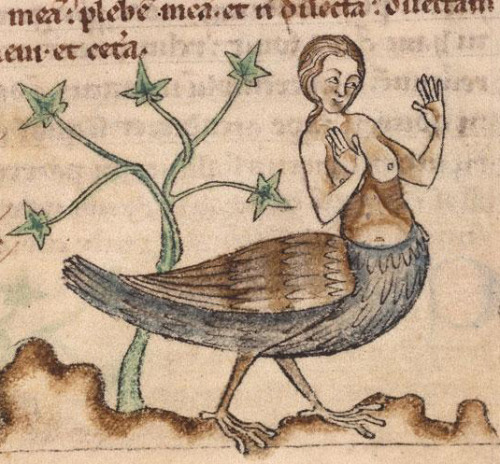
public domain Douai, Bibliothèque municipale, 0711, detail of f. 32. De natura animalium (13th century)
1 note
·
View note
Photo
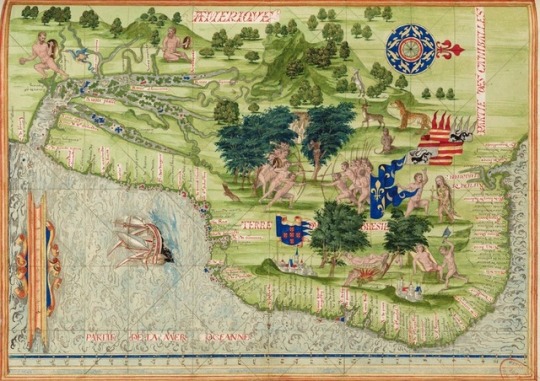
COLONIAL CARTOGRAPHY: This map of Brazil, by Guillaume Le Testu (c. 1509-12 – April 29, 1573), a French privateer, explorer, and one of the foremost cartographers of his time and an author of the Dieppe maps.
In 1550, King Henry II commissioned Le Testu to make a map of the Americas, particularly where the French were trading. In 1551, Le Testu sailed to Brazil on a reconnaissance mission for Henry II, charting as far as the Rio de la Plata.
Le Testu was also involved in the founding of a French colony near Rio de Janeiro in 1555. He published in 1555-56 a world atlas entitled Cosmographie Universelle, which contained 56 maps, including the map above.
In 1573, he and Sir Francis Drake attacked a Spanish mule train escorting gold and silver to Nombre de Dios on the Atlantic coast of Panama. Le Testu was subsequently killed, following his capture by the Spanish.
#cartography#maps#historical cartography#guillaume le testu#cosmographie universelle#rio de janeiro#brasil#brazil#highlight
6 notes
·
View notes
Photo

Illustration: "Pourtraict du Limaçon poisson monstrucux" from La cosmographie universelle, Paris: 1575. By André Thevet (1516-1590). Typ 515.75.831, Houghton Library, Harvard University
Date 1575
21 notes
·
View notes
Photo
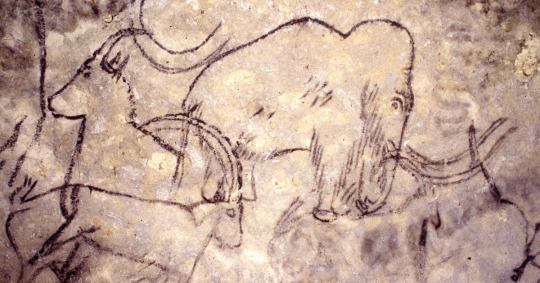




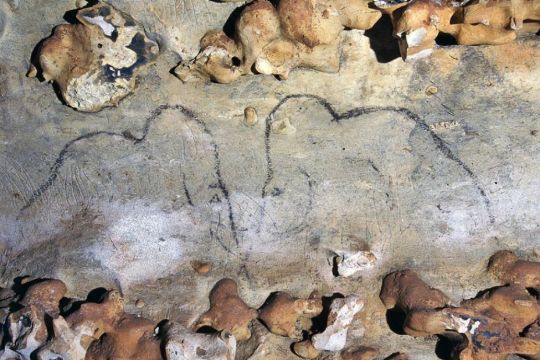
The Cave Of The Hundred Mammoths
The Rouffignac cave is a cave located in the department of Dordogne in France and is also known as the cave of the hundred mammoths thanks to its 255 cave paintings of which 62% represent a mammoth. The cave itself is big, it has over 10 kilometers of underground passageways and shafts that lead to even deeper levels not fully explored. In total, 12 kilometers of the cave has been explored and visitors can take a tour on a train that will take them about 2km far into the cave.
Earliest mentions of the cave dates back to 1575 when writer and painter François Belleforest described strange paintings and footprints of various animals in his work 'Cosmographie Universelle'. During the 19th century, the cave became a tourist attraction because of the paintings but nobody yet realised that these paintings were actually made during the paleolithic era.
It wasn't until the 1950's when several researchers (Romain Robert, Louis-René Nougier, Charles and Louis Plassard) entered the cave and noticed that the paintings inside were of great historical value. In 1957 the cave became a listed site and it was finally confirmed that the art inside, is in fact prehistoric in nature and thus of incredible archeological value.
The art inside the cave is not the oldest art found in Europe. The art of Rouffignac is dated back to about 13,000 years ago from the Magdalenian culture, in comparison the art of Chauvet cave is about 30,000 years old. What is quite fascinating is the fact that 62% of all the paintings, 158 in total, represent a mammoth. There are 29 depictions of bison, 16 of a horse, 12 of an ibex, 11 of a rhino, 6 of a snake, 4 of a human, 1 of a bear and 14 abstract paintings.
Some of the art has been made in quite difficult positions inside the cave, it's amazing to think that humans were able to explore this cave 13,000 years ago and make these pieces of art. There must have been a reason behind all of this art because no one would enter this cave that deeply to create art in pitch black and dangerous surroundings in prehistoric times, even with all of our current gear and knowledge humans wouldn't even do this for fun in the 21st century. The possible spiritual meaning behind cave art still remains a mystery yet an incredibly fascinating topic to explore.
Why is there such an abundance of mammoth cave art in Rouffignac? We actually have no idea why. Perhaps our ancestors viewed the woolly mammoth as a particularly sacred animal, maybe their spiritual beliefs were based on the spirit of the mammoth. These are just wild guesses because in truth, it is impossible to find any archeological evidence inside this cave that explains the reason why there are so many depictions of a mammoth. One thing that is certain is that the mammoth continues to fascinate human beings until this very day, I myself got a tattoo of a woolly mammoth based on art found inside this cave.
Here are images of:
Rouffignac cave art
2K notes
·
View notes
Text
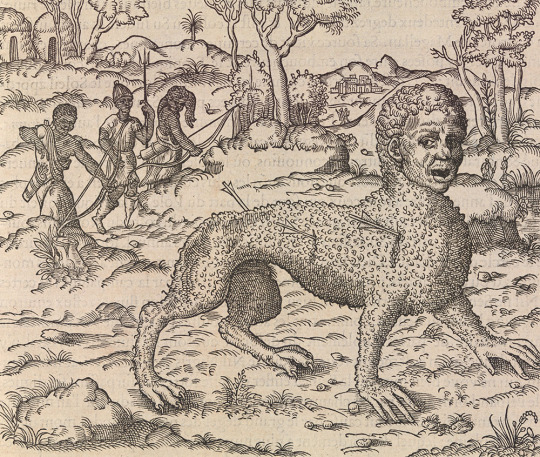
This 16th-century artwork shows a group of hunters attacking a 'thanacth'. This mythical creature was believed to live in the Calcutta region of India. This artwork comes from 'Cosmographie universelle' (1575) by the French explorer and writer Andre Thevet (1516-1590). The description of this creature resembles that of a tiger.
#library#law library#mtlibrary#inns of court#libraries#rare books#history#books & libraries#rarebook
55 notes
·
View notes
Photo
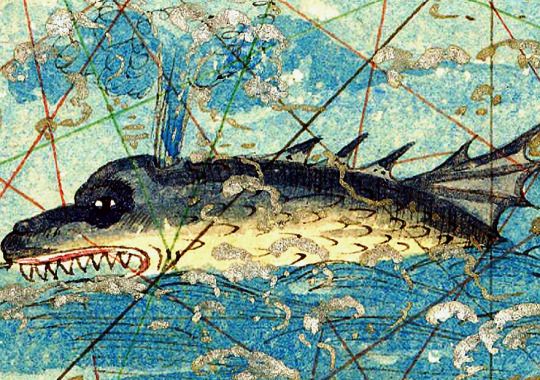
Les créatures fabuleuses dans les cartes marines. Cosmographie universelle (détail), Guillaume Le Testu. Le Havre ~ 1556 • via Bibliothèque Infernale on FB
68 notes
·
View notes
Photo
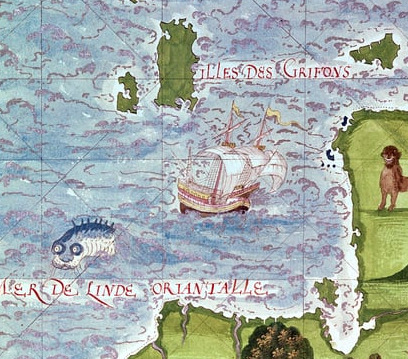
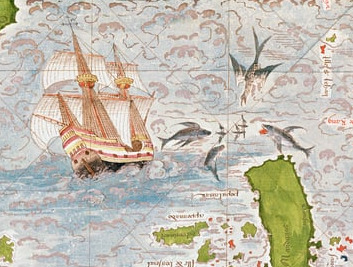
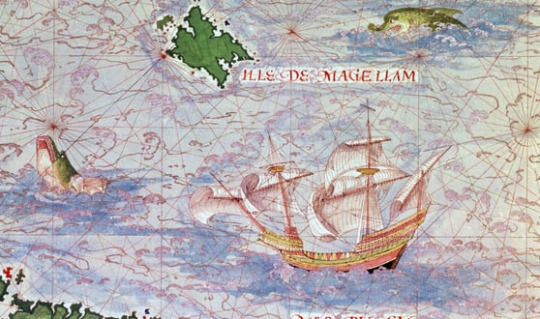


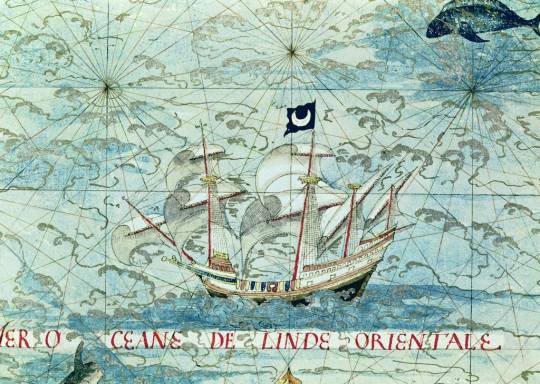

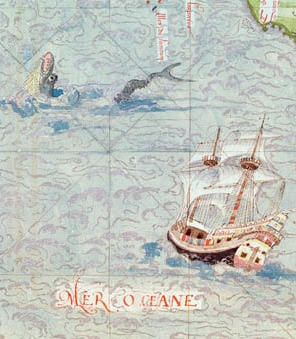
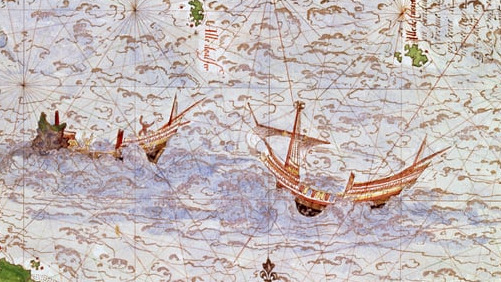
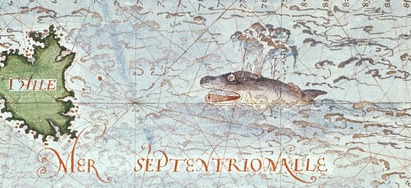
Ships and Sea Monster details from Guillaume le Testu/ Têtu’s Cosmographie Universelle selon les Navigateurs, tant anciens que modernes (1555)
Le Testu or Têtu (1509-12 – April 29, 1573) was a French Privateer, explorer and navigator. He was one of the most important cartographers of his time and author of the maps of Dieppe and the Cosmographie Universelle a world atlas. His maps were distinguished by their sophistication and detail and influenced generations of cartographers, navigators and explorers to the extent that many followed his style.
129 notes
·
View notes
Text
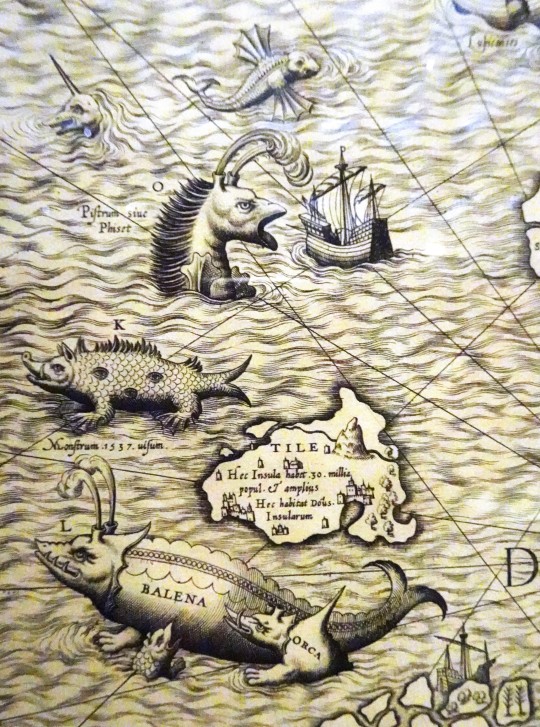




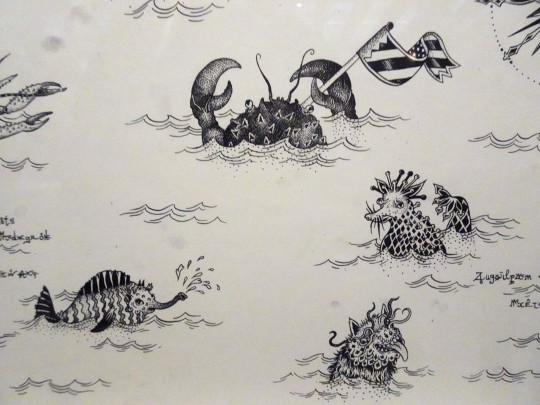


Il y a une petite quinzaine, je suis allé avec Julien et Katie, au Louvre-Lens pour une expo temporaire : “Animaux Fantastiques”. Une très belle expo ! Ici des monstres marins :
les 3 premiers : Olaus Magnus - "Carte marine et description des Terres Septentrionales", représentation un brin fantasmée de la Scandinavie - Rome, 1572
Sébastien Münster - "Cosmographie Universelle" - Paris, 1553
les 2 suivants : Claire Fanjul - "Grande Terra Incognita"
Jean-Auguste-Dominique Ingres - "Roger délivrant Angélique"
Paolo Forlani, sur un modèle de Giacomo Gastaldi - mappemonde - Venise, 1562
#expo#louvre-lens#animaux fantastiques#monstre#créature#monstre marin#léviathan#olaus magnus#renaissance#sebastien münster#cosmographie#claire fanjul#terra icognita#paolo fortani#mappemonde#carte marine#giacomo gastaldi#scandinavie
2 notes
·
View notes
Photo
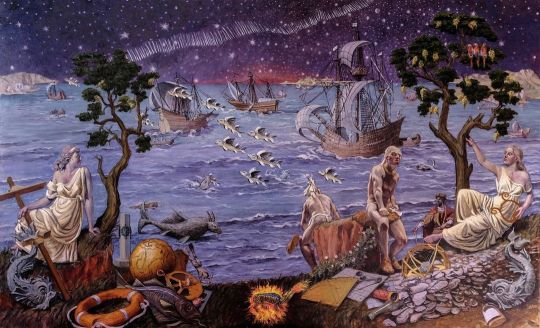
1524, Route des Amériques. Based on the frontispiece of “Cosmographie Universelle” by André Thevet published in 1575, Paris. En route for China, the European explorers encountered the Americas thanks to new means of navigation displayed on the foreground. Oil on canvas, 60” x 98”, September 2021. #16thcentury #americas #magicrealism #realismemagique #realismomagico #oilpainting #fredericlere #ronsardlere (at America) https://www.instagram.com/p/CUdLCXJIwlf/?utm_medium=tumblr
#16thcentury#americas#magicrealism#realismemagique#realismomagico#oilpainting#fredericlere#ronsardlere
1 note
·
View note